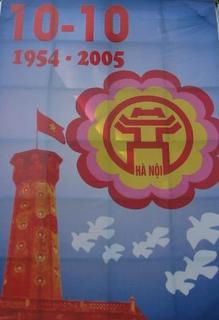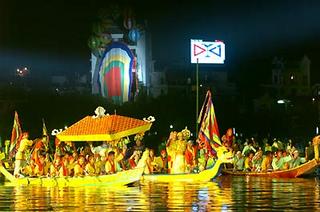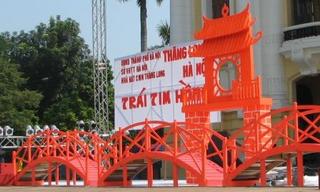Saturday, June 16, 2007
Boat Trip Along Perfume River In Hue
Our first stop on the trip was Thien Mu Pagoda. This is such an old and beautiful pagoda located on a hill, right on the right bank of the Huong River. We spent 45 minutes taking photos and listening to Nghia talking about the pagoda's great history.
Tu Duc tomb was the second stop and this was the best stop for the whole trip because the tomb was amazingly beautiful, old and huge. We had to pay 20,000Vnd for a return trip from the boat dock to the Khai Dinh tomb by motorbike and 30,000Vnd to enter compared to 55,000Vnd for western tourists.
Khai Dinh tomb was the third stop and we stayed there over an hour walking around. The chambers inside the building were quite incredible, with lots of mosaic work.
Next up was Hon Chen temple which is not as interesting perhaps because I've been here before. It's a small temple right by the river, up about 100 steps. I think it was just a convenient place to get us off the boat so the staff could prepare and set up for lunch.
Minh Mang tomb was the last stop before heading back to the city. This one is also surrounded by huge and beautiful pavilions and gardens. We spent about an hour here before the rain came down. All the way back on the boat, it poured. Lucky for us!
We had such a great day seeing the tombs and learning a bit of history for only 25,000Vnd, which included a lunch of veggies, eggs and meat. The tour guide had a tough day coping with all of our questions but we offered him drinks and a tip at the end. Thank you very much Nghia for a lovely day.
Sunday, November 26, 2006
Then and Now Part II
I remember we had some chickens, ducks and pigs at home. I had to help my brother and sisters to cook the food for the pigs and give them a bath and sometimes had to take pig shit to my neighbors, and dig it into the land. Not the best household job! In those days, most families had pigs or chickens or ducks around their houses, but the most popular were pigs and chickens. We used to eat the chicken eggs and sell them to get money or exchange them for some other food.
"The system of distributing subsidised food produce affected people who did not work in agricultural section from the wartime until 1989. The system's rice stores were perhaps its most essentail components; people's lives were directly dependant on them". This was very true and my family were lucky because my mother was a rice shop manager so we had better options to choose our own rice and we didn't have to queue that much.
Some people weren't as lucky as us. As Mr Ngo Duc Thinh, aged 63, prof.Ph.D, room 912, A6 Giang Vo Street, said "After taking the rice home I would open the sack immediately: if the rice wasn't smelly I would feel happy the whole day."
"His face is as sad as if he had lost his rice book!"(an idiom in subsidy period).
Tobe continued.
Now and Then Part III
This man's story reminds me of the time when I had to go to buy two train tickets for my relative with my sister. We had to queue for most of the morning at the station but we couldn't get the tickets so we were forced to get 2 tickets from "black market" traders. We pay 3 hao (about 50,000VND/US$3.20 in today's money, I guess) more than the official price but we decided to do that in future to save time.
Sunday, November 19, 2006
Now And Then Part I
Here are some extracts from the musuem brochure about that time:
"The period of the "Subsidy Economy, 1975- 1986" has been known as a time of hardships, when mechanism for socio-economic management was inappropriate, causing privations in people's material and spiritual life. Material life was poor due to a sluggish and inefficient production system, but the constraints also applied to people's creative and spiritual endeavors."
"Almost all commodities were distributed to people through a system of state and cooperatives. Distribution of goods was dependent on the rank of the citizen and distributed by the using coupons or food stuff books. High ranking officals were served at special shops,whereas a number of other stores in the city were for common people".
"Food was bought with coupons that had a lot of small spuares. Sometimes, in order to buy green vegetables or even to buy some oranges in the summer, you needed to cut the different squares on the coupons" said by Mrs Le Thi Hien, aged 69, former head of the Dong Xuan vegetable and fruit shop,85 Hang Buom street, Hanoi.
Yes, this is so right, I remember my family had to go to the shop very early sometimes to put a brick or stand there for hours just to buy some veggies or some meat. But luckily, at that time I was only about 6 or 7 years old and people saw me as a tiny kid and they always let me buy my stuff first. One day, on the way I lost my coupon which had just 3 squares left. I was really nervous and expected a big slap on my bum from my Mum when I got home. But my mother didn't do that. She told me have to be more careful next time.
My parents both worked for the government as managers so, while our life was still difficult, it was worse for other families.
To be continued
Sunday, May 21, 2006
116 Years Vietnamese Hero's Birthday
 May 19 is a very special day as it's Ho Chi Minh's birthday and this day is stuck deeply inside every Vietnamese heart, respectful and proud.
May 19 is a very special day as it's Ho Chi Minh's birthday and this day is stuck deeply inside every Vietnamese heart, respectful and proud.Everywhere in Viet Nam this day is celebrated with lots of different performance and there are also lots of painting and photo exhibitions happening a few days before. The government also convenes lots of meetings to talk about Uncle Ho and the Ho Chi Minh mausoleum is a place to go for so many many people around Viet Nam, who just want to come here to see him and talk about him together and think about what he had done to help Viet Nam become great. They dressed up in different ways such as long dresses, suits and so many of them wear a yellow head band on their heads to show that they are Unclo Ho's children. Yes, we are all a part of him in mind and spirit.
There are so many magazines in and out of Viet Nam writing about him and they keep talking about how great he was to lead the country in such a right way. Writing about Uncle Ho is so difficult for me because I don't know the right words to express my feelings for him. He is not only my hero, he is a grand hero all over Vietnam. As I always say to my friends and tell myself that I am Vietnamese and always will be.
Saturday, February 25, 2006
Ho Chi Minh Museum

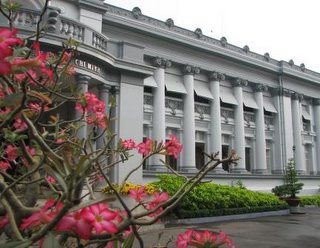

Ho Chi Minh museum in Ho Chi Minh city is the only museum that interested me, which shows many of the things that remain of Uncle Ho from the war.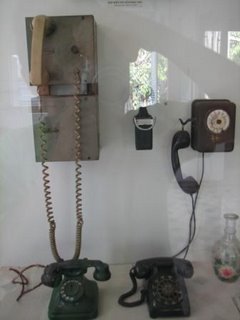
All of the pictures and objects here are explained clearly with information on the side of each that helps people to understand them clearly.

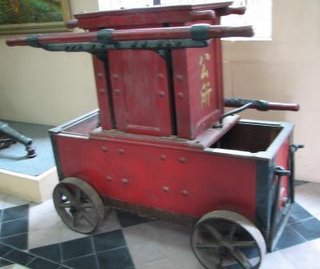 Besides all of the guns, tanks and radios, this museums exhibits lots of very interesting things from coal irons, fire trucks and some different cars that people used before and during the war.
Besides all of the guns, tanks and radios, this museums exhibits lots of very interesting things from coal irons, fire trucks and some different cars that people used before and during the war.

I think you will not believe your eyes when you see lots of the things that Vietnamese soldiers and Vietnamese people used during the war. These resourceful people recycled enemy bullets, bombs and parts of aircraft to make fry pans, helmets, food containers and knives as well as gifts and souvenirs for friends and family.
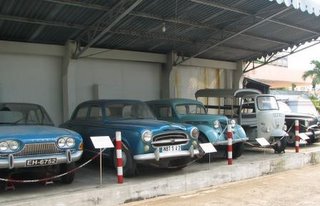
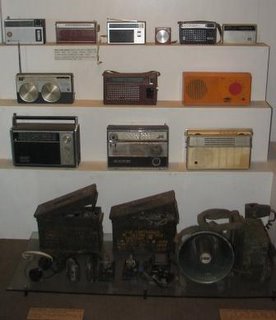 I was so glad to visit this museum as it has helped me to better understand about how hard it must have been to win the war with nothing much to work with. I dont want to make it become a huge deal in this post but I am so proud about being Vietnamese.
I was so glad to visit this museum as it has helped me to better understand about how hard it must have been to win the war with nothing much to work with. I dont want to make it become a huge deal in this post but I am so proud about being Vietnamese.
Thursday, October 13, 2005
Flying Dragon - A Thousand Years Of History
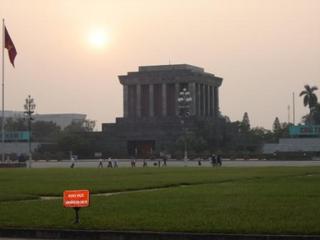 Vietnam has been a French colony, and partly under American administration. Hanoi is one city which had lots of damage in past wars. We love peace and we have actually tried our best to build up the city that won the city of peace award from UNESCO last year. Since independence, Hanoi has improved so fast. Vietnam is continuing to open and wants everyone of all countries to come and invest. That past is not all forgotten here but we want a better world of peace and happiness.
Vietnam has been a French colony, and partly under American administration. Hanoi is one city which had lots of damage in past wars. We love peace and we have actually tried our best to build up the city that won the city of peace award from UNESCO last year. Since independence, Hanoi has improved so fast. Vietnam is continuing to open and wants everyone of all countries to come and invest. That past is not all forgotten here but we want a better world of peace and happiness.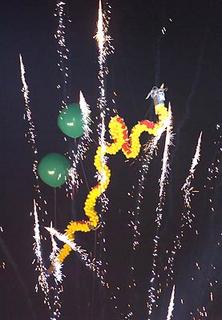
David Lamb, a very famous journalist from the Los Angeles Times was a war reporter in the south of Vietnam, thought of Hanoi, before he returned to Vietnam in 1997 as "a city of war ruins." After that, he wrote in the National Geographic that "Hanoi has pushed the ghosts of war away" and that "Hanoi is a city full of vitality and beautiful scenery, of gracious lakes surrounding old trees and French buildings."

Travel Leisure-America tour magazine voted Hanoi as one of the best five cities in Asia based on its people, food, traditions and history, following a million votes from readers around the world. This is the second year that Hanoi has been honored with this award.

Hanoi has also held a very successful ASEM conference, big sport events such as the Sea Games, Tiger Cup and many other political events that have made a good impression to international organizations.
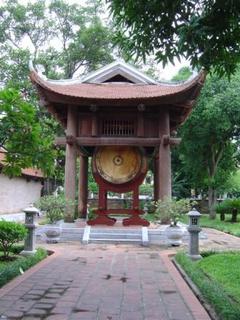
Hanoi has almost a thousand years of history, recognized easily by the old houses in the old quarter, the thousand year old trees around the city and lots of old French buildings surrounding the city. Hanoians are also slightly different to people from other parts of Vietnam. The elegant way that Hanoians dress, eat, walk and talk makes the difference.

There are so many fairs and festivals these days to celebrate the pride of Hanoi. So many cultural activities, about such things as Hanoi fashion history, music shows, childrens' painting, poetry readings and food festivals.

The changes in Hanoi nowadays also have an effect on traditional behavior. Our lifestyle has changed a bit, the way young people behave but this reality is happening to all countries in the world. This development brings both good and bad but we should try to manage the bad things to the lowest percentage as possible and keep working on it.
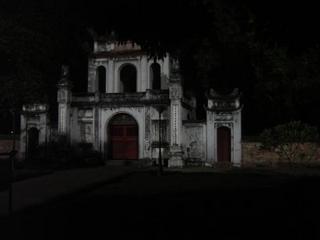
Whenever visitors come to Hanoi, they like to visit all of the very interesting, old traditional villages such as Bat Trang- Ceramic village, Van Phuc- Silk village, Dong Ky- Firecracker village, Dong Hong- painting village, Le Mat- Snake village and don't forget the But Thap pagoda, Ambassador's pagoda and Tran Quoc pagoda which are beautiful and really old. Van Mieu Quoc Tu Giam is the place you must go to see the first Vietnamese university which is located near Uncle Ho's mausoleum. The Ho Chi Minh museum, Fine arts museum, Revolutionary museum, museum of Ethnology, History museum and Hoa Lo prison museum are places also worth visiting.

The Water Puppets is a great traditional show worth attending because of the talented actors and actresses, which can only be seen in Vietnam. Don't miss it!
 Two days ago, on 1o October, Hanoians celebrated 995 years of history (the old name, Thang Long, means Flying Dragon), and lots of people came to Hanoi during this really special event to remember and imagine how this old and great city once was.
Two days ago, on 1o October, Hanoians celebrated 995 years of history (the old name, Thang Long, means Flying Dragon), and lots of people came to Hanoi during this really special event to remember and imagine how this old and great city once was.
